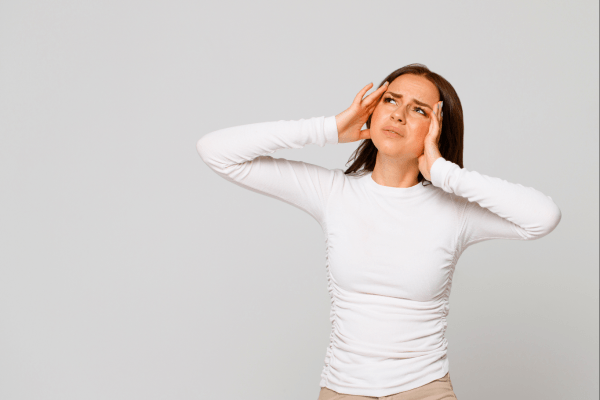For many, a bustling city street, a crowded shopping mall, or a noisy restaurant is a mildly overwhelming, but ultimately manageable experience. But for individuals living with vestibular disorders like Vestibular Migraine or Persistent Postural-Perceptual Dizziness (PPPD), these environments can feel like a neurological minefield—disorienting, exhausting, and sometimes outright disabling.
So why do busy environments trigger such intense discomfort in people with vestibular disorders? The answer lies in the intricate connections between the brain, eyes, inner ear, and nervous system—and how these connections become disrupted when the vestibular system isn’t functioning properly.
Let’s explore the reasons in depth.
Understanding the Vestibular System
The vestibular system is the body’s balance centre. It includes parts of the inner ear and brain that help control balance, spatial orientation, and coordination. It works closely with the visual system (eyes) and proprioceptive system (muscles and joints) to help you stay upright and oriented in your environment.
When functioning properly, the vestibular system continuously integrates signals from:
- The inner ear (detecting head position and motion)
- The eyes (tracking movement and surroundings)
- The muscles and joints (sensing the body’s position)
This coordination allows you to walk steadily, move through space, and look around without feeling dizzy or off-balance.
In vestibular disorders, this system becomes dysfunctional or hypersensitive—leading to dizziness, vertigo, imbalance, nausea, and what many describe as “brain fog” or disconnection from the body and surroundings.
Vestibular Migraine and PPPD: A Double Whammy
Vestibular Migraine and PPPD are two of the most common chronic vestibular disorders, and they often coexist or trigger each other.
- Vestibular Migraine involves migraine symptoms—like head pain, aura, light/sound sensitivity—along with vestibular symptoms like vertigo, dizziness, or visual motion sensitivity. Even without a classic headache, the brain becomes hypersensitive to sensory input.
- PPPD is a functional neurological disorder characterised by persistent dizziness (often perceived as a rocking and swaying sensation) and unsteadiness that worsens with motion, upright posture, and visual complexity. It’s not caused by structural damage, but rather by the brain staying “on alert” even after a triggering event (like vestibular migraine or an inner ear infection such as Vestibular Neuritis).
Both conditions cause the brain to become overly vigilant and reactive to environmental stimuli—especially complex, busy ones.
Why Busy Environments Are So Difficult
Here are the main reasons busy, crowded spaces can be so difficult for those with vestibular disorders:
1. Visual Overload and Motion Sensitivity
In busy environments—like supermarkets, shopping centres, train stations, or airports—there’s a constant stream of visual motion: people moving, bright lights, scrolling signs, blinking screens, flashing lights. For the average brain, this is just background noise. But for someone with a vestibular disorder, this motion can become overwhelming.
- Visual dependence is common in vestibular disorders. When the inner ear’s balance input is unreliable, the brain leans more heavily on vision for orientation.
- But in a chaotic environment, the visual system becomes overloaded. The brain can’t keep up with interpreting all the movement around it. This leads to motion-triggered dizziness, nausea, or a sense of unreality (derealisation).
- PPPD in particular is characterised by visual vertigo—where even subtle motion, like scrolling through a phone or watching people walk by, can trigger symptoms.
2. Sensory Mismatch and Brain Fatigue
Our brains rely on a coordinated “agreement” between the vestibular, visual, and proprioceptive systems to understand our position in space. When these inputs don’t match, the brain enters a state of conflict.
In vestibular disorders:
- The inner ear may say one thing (e.g., “you’re moving”)…
- The eyes say another (e.g., “you’re standing still”)…
- And the body sends yet another signal…
This sensory mismatch creates confusion in the brain, which leads to dizziness, imbalance, and anxiety. In crowded environments, the constant barrage of conflicting inputs overwhelms the brain’s ability to compensate.
Over time, this overload causes neurological fatigue—mental exhaustion, trouble focusing, irritability, and even panic. Many people describe a “shut down” feeling or the need to immediately escape.
3. Auditory Overstimulation and Hypervigilance
Vestibular disorders often affect more than just balance. The auditory system—especially in Vestibular Migraine—is also involved. Many people develop phonophobia (sensitivity to sound), or difficulty processing complex auditory input.
Crowded environments are filled with sound layers: music, chatter, machinery, announcements, clinking dishes, traffic. The brain of someone with a vestibular disorder can struggle to filter and prioritise these sounds.
The result?
- Heightened anxiety
- Feelings of disorientation
- Worsening dizziness or migraines
Some may also experience misophonia—an emotional reaction to certain sounds—or feel as if sound is distorted or too loud (hyperacusis), even when others perceive it as normal.
4. Anxiety and the Fight-or-Flight Response
An under-recognised feature of vestibular disorders is how they trigger the brain’s fear and threat systems. The vestibular system shares deep connections with the limbic system, which governs emotion, threat detection, and survival.
When the brain receives conflicting sensory signals, or senses a loss of orientation, it interprets this as a potential threat—activating the fight-or-flight response.
In crowded spaces:
- Escape routes may feel blocked.
- Sensory input may feel uncontrollable.
- The brain interprets the environment as unsafe.
This leads to a feedback loop:
- Dizziness → anxiety → more dizziness → panic.
- The person may start avoiding such environments, which reinforces fear and sensitivity.
In PPPD, this pattern becomes chronic. Even after the initial vestibular event has resolved, the brain remains locked in hypervigilance, interpreting normal sensory input as dangerous.
5. Postural Instability and Movement Difficulty
People with vestibular disorders often rely more on their vision to stay upright. In busy places, when visual input is compromised, it becomes harder to control posture or walking.
Many report:
- Feeling like they’re walking on a boat or trampoline.
- Needing to hold onto walls or shopping carts.
- Being unsure of their footing, especially on patterned floors or stairs.
Crowds make this worse by limiting personal space and requiring quick navigational adjustments, which the vestibular system may struggle to make.
How to Cope in Crowded Environments
While busy spaces may always pose a challenge, many people find relief and empowerment through a combination of strategies:
1. Vestibular Rehabilitation Therapy (VRT)
This specialised form of physiotherapy helps retrain the brain to tolerate motion and resolve sensory conflicts. Exercises may include balance training, desensitisation exercises, and visual tasks specific to the environments which are troublesome.
2. Cognitive Behavioral Therapy (CBT)
Especially helpful for PPPD, CBT targets the fear-avoidance cycle and helps reframe distressing thoughts related to dizziness or disorientation.
3. Gradual Exposure
Instead of avoiding busy environments completely, gradual, controlled exposure can desensitise the brain and rebuild confidence. For example, visiting a quiet store at off-peak times and slowly working up to busier settings.
4. Sensory Modulation Tools
- FL-41 tinted glasses, such as Auvulux or TheraSpecs, can reduce visual sensitivity to fluorescent lighting, screen glare, and motion.
- Noise-canceling earplugs, like Loop Earplugs, help reduce auditory overload without fully cutting off environmental awareness.
5. Medications, such as migraine preventives or SSRIs/SNRIs (e.g., Venlafaxine) may help regulate sensory processing, anxiety, and dizziness. These should only be started under the care of a Neuro-otologist or Neurologist experienced in treating vestibular conditions.
6. Mind-Body Practices
Breathing exercises, grounding techniques, yoga, and mindfulness can help the nervous system shift out of hypervigilance and support long-term vestibular recovery.
Conclusion: The Invisible Struggle
Vestibular disorders like Vestibular Migraine and PPPD are invisible but deeply impactful. Crowded environments can feel like hostile territory to someone whose brain is constantly trying—and failing—to make sense of sensory input. What looks like “just a trip to the store” for one person may feel like navigating a maze of nausea, imbalance, and panic for another.
Understanding the science behind these symptoms not only validates the experience of those who suffer—it also paves the way for more compassionate environments, informed treatment approaches, and better self-care strategies.
If you or someone you know is living with a vestibular condition, know this: you’re not alone, and there is hope. With the right support and tools, it’s possible to reclaim life, one step—and one quiet corner—at a time.
If this post resonates with you contact The Vertigo Co for an appointment and hopefully we can assist you on your path to recovery.






